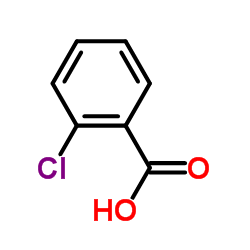邻氯苯甲酸

邻氯苯甲酸结构式

|
常用名 | 邻氯苯甲酸 | 英文名 | 2-Chlorobenzoic acid |
|---|---|---|---|---|
| CAS号 | 118-91-2 | 分子量 | 156.566 | |
| 密度 | 1.4±0.1 g/cm3 | 沸点 | 275.7±13.0 °C at 760 mmHg | |
| 分子式 | C7H5ClO2 | 熔点 | 138-140 °C(lit.) | |
| MSDS | 中文版 美版 | 闪点 | 120.5±19.8 °C | |
| 符号 |

GHS07 |
信号词 | Warning |
|
Benzenepolycarboxylic acids with potential anti-hemorrhagic properties and structure–activity relationships
Bioorg. Med. Chem. 19 , 7000-2, (2011) Previously, we reported the structural requirements of the cinnamic acid relatives for inhibition of snake venom hemorrhagic action. In the present study, we examined the effect of benzenepolycarboxylic acids and substituted benzoic acids against Protobothrop... |
|
|
Pseudomonas aeruginosa 142 uses a three-component ortho-halobenzoate 1,2-dioxygenase for metabolism of 2,4-dichloro- and 2-chlorobenzoate.
J. Bacteriol. 176(11) , 3368-74, (1994) Cell extracts of Pseudomonas aeruginosa 142, which was previously isolated from a polychlorinated biphenyl-degrading consortium, were shown to degrade 2,4-dichlorobenzoate, 2-chlorobenzoate, and a variety of other substituted ortho-halobenzoates by a reaction... |
|
|
Complete genome sequence of the haloaromatic acid-degrading bacterium Achromobacter xylosoxidans A8.
J. Bacteriol. 193(3) , 791-2, (2011) Achromobacter xylosoxidans strain A8 was isolated from soil contaminated with polychlorinated biphenyls. It can use 2-chlorobenzoate and 2,5-dichlorobenzoate as sole sources of carbon and energy. This property makes it a good starting microorganism for furthe... |
|
|
2-Chlorobenzoic acid and 2,5-dichlorobenzoic acid metabolism by crude extracts of Pseudomonas sp. CPE2 strain.
Lett. Appl. Microbiol. 22(4) , 275-9, (1996) Crude extracts of Pseudomonas sp. CPE2 strain, which is capable of growing on 2-chlorobenzoic acid (2-CBA) and 2,5-dichlorobenzoic acid (2,5-dCBA) in the absence of other carbon sources, were found to be capable of bioconverting 2-CBA and 2,5-dCBA to catechol... |
|
|
Degradation of 2-chlorobenzoic and 2,5-dichlorobenzoic acids in soil columns by Pseudomonas stutzeri.
Folia Microbiol. (Praha) 38(5) , 376-8, (1993) The heterocontinuous flow cultivation technique was used for the study of 2-chlorobenzoic and 2,5-dichlorobenzoic acid degradation in soil columns inoculated with Pseudomonas stutzeri. 2-Chlorobenzoic and 2,5-dichlorobenzoic acids disappeared from the soil co... |
|
|
Two-dimensional capillary electrophoresis using tangentially connected capillaries.
J. Chromatogr. A. 1154(1-2) , 454-9, (2007) A novel type of fused silica capillary system is described where channels with circular cross-sections are tangentially in contact with each other and connected through a small opening at the contact area. Since the channels are not crossing each other in the... |
|
|
Temperature-dependent biotransformation of 2,4'-dichlorobiphenyl by psychrotolerant Hydrogenophaga strain IA3-A: higher temperatures prevent excess accumulation of problematic meta-cleavage products.
Lett. Appl. Microbiol. 44(4) , 447-53, (2007) The present work investigates the possibility that temperature could regulate the pattern of transformation of 2,4'-chlorobiphenyl (2,4'-CB) by psychrotolerant Hydrogenophaga sp. IA3-A.Transformation of 2,4'-chlorobiphenyl to 2- and 4-chlorobenzoic acid (2- a... |
|
|
Mutational analysis of the inducer recognition sites of the LysR-type transcriptional regulator TfdT of Burkholderia sp. NK8.
Appl. Microbiol. Biotechnol. 83(6) , 1085-94, (2009) TfdT is a LysR-type transcriptional regulator that activates the transcription of the chlorocatechol degradative gene operon tfdCDEF of the chlorobenzoate-degrading bacterium Burkholderia sp. NK8. To identify the amino acids involved in the effector recogniti... |
|
|
The metabolism and excretion of [14c] 2- and 4-chlorobenzoic acids in the rat.
J. Pharm. Biomed. Anal. 22(6) , 1023-8, (2000) The metabolic fate of [14C]-labelled 2 and 4-chlorobenzoic acids (2- and 4-CBA) has been determined in the rat following intraperitoneal (i.p.) administration at 100 mg/kg to male rats. The major route of elimination for both 2-and 4-CBA was urine with > 80%,... |
|
|
2-Chlorobenzoate biodegradation by recombinant Burkholderia cepacia under hypoxic conditions in a membrane bioreactor.
Water Environ. Res. 77(5) , 511-8, (2005) The feasibility of applying bacterial hemoglobin technology to degrade 2-chlorobenzoate (2-CBA) through co-metabolism under hypoxic conditions in a membrane bioreactor (MBR) process has been studied in the laboratory. 2-chlorobenzoate removal and chloride rel... |